

Wordnet. Computational_semantics. Attempto Project. Latent semantic analysis. Latent semantic analysis (LSA) is a technique in natural language processing, in particular in vectorial semantics, of analyzing relationships between a set of documents and the terms they contain by producing a set of concepts related to the documents and terms.
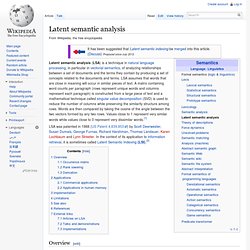
LSA assumes that words that are close in meaning will occur in similar pieces of text. A matrix containing word counts per paragraph (rows represent unique words and columns represent each paragraph) is constructed from a large piece of text and a mathematical technique called singular value decomposition (SVD) is used to reduce the number of columns while preserving the similarity structure among rows. Words are then compared by taking the cosine of the angle between the two vectors formed by any two rows. Values close to 1 represent very similar words while values close to 0 represent very dissimilar words.[1] Overview[edit] Occurrence matrix[edit] Generative grammar. Early versions of Chomsky's theory were called transformational grammar, and this term is still used as a general term that includes his subsequent theories.
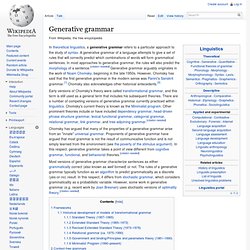
There are a number of competing versions of generative grammar currently practiced within linguistics. Chomsky's current theory is known as the Minimalist program. Other prominent theories include or have included dependency grammar, head-driven phrase structure grammar, lexical functional grammar, categorial grammar, relational grammar, link grammar, and tree-adjoining grammar.
Construction grammar. In linguistics, construction grammar groups a number of models of grammar that all subscribe to the idea that knowledge of a language is based on a collection of "form and function pairings".
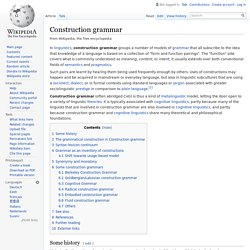
The "function" side covers what is commonly understood as meaning, content, or intent; it usually extends over both conventional fields of semantics and pragmatics. Construction grammar (often abridged CxG) is thus a kind of metalinguistic model, letting the door open to a variety of linguistic theories. It is typically associated with cognitive linguistics, partly because many of the linguists that are involved in construction grammar are also involved in cognitive linguistics, and partly because construction grammar and cognitive linguistics share many theoretical and philosophical foundations.
Some history[edit] Construction grammar was spurred on by the development of Cognitive Semantics, beginning in 1975 and extending through the 1980s. Fillmore et al.' Image schema. Figure 1 - Containment Image Schema In contemporary cognitive linguistics, an image schema is considered an embodied prelinguistic structure of experience that motivates conceptual metaphor mappings.
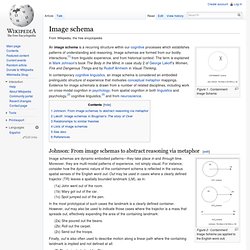
Evidence for image schemata is drawn from a number of related disciplines, including work on cross-modal cognition in psychology, from spatial cognition in both linguistics and psychology,[2] cognitive linguistics,[3] and from neuroscience. [edit] Figure 2 - Containment Image Schema (as applied to the English word out) Image schemas are dynamic embodied patterns—they take place in and through time. . (1a) John went out of the room. (1b) Mary got out of the car. Schema (Kant) In Kantian philosophy, a transcendental schema (plural: schemata) is the procedural rule by which a category or pure, non-empirical concept is associated with a sense impression.
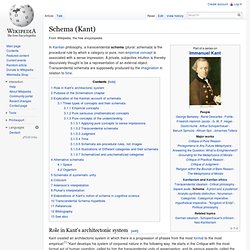
A private, subjective intuition is thereby discursively thought to be a representation of an external object. Transcendental schemata are supposedly produced by the imagination in relation to time. Kant created an architectonic system in which there is a progression of phases from the most formal to the most empirical:[1] "Kant develops his system of corporeal nature in the following way. He starts in the Critique with the most formal act of human cognition, called by him the transcendental unity of apperception, and its various aspects, called the logical functions of judgment.
Www.aclweb.org/anthology/O/O05/O05-5012.pdf. EXCOM. The Suggested Upper Merged Ontology (SUMO) - Ontology Portal. ATT-Meta Metaphor View Database. Welcome. From Molecule to Metaphor. UNDL Foundation - Home. Introduction to UNL - UNL Wiki. The Universal Networking Language (UNL) is an artificial language created to represent and process information across language barriers. History The UNL Programme started in 1996, as an initiative of the Institute of Advanced Studies of the United Nations University in Tokyo, Japan. In January 2001, the United Nations University set up an autonomous organization, the UNDL Foundation, to be responsible for the development and management of the UNL Programme.
The Foundation, a non-profit international organisation, has an independent identity from the United Nations University, although it has special links with the United Nations. UNDL Foundation - Home Page. Mundane - Google Search. ATT-Meta Project MENTAL METAPHOR DATABANK. Concerning COPYRIGHT: This databank must not be used for commercial purposes.
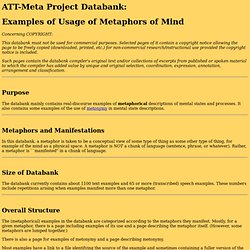
Selected pages of it contain a copyright notice allowing the page to be freely copied (downloaded, printed, etc.) for non-commercial research/instructional use provided the copyright notice is included. Such pages contain the databank compiler's original text and/or collections of excerpts from published or spoken material to which the compiler has added value by unique and original selection, coordination, expression, annotation, arrangement and classification. Purpose The databank mainly contains real-discourse examples of metaphorical descriptions of mental states and processes.
Metaphors and Manifestations. The OU : CREET : Metaphor Analysis. Metaphor Analysis Project > About the Metaphor Analysis Project and MetNet The Metaphor Analysis project is a research project funded by the ESRC's National Centre for Research Methodology.
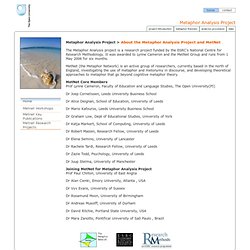
It was awarded to Lynne Cameron and the MetNet Group and runs from 1 May 2006 for six months. The OU : CREET : Metaphor Analysis. Metaphor Analysis Project > Good Practice Metaphor Analysis: Training Workshop The Open University, 20 September, 2006.
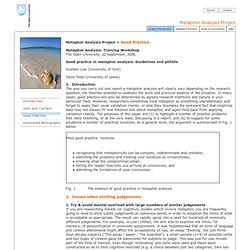
Good practice in metaphor analysis: Guidelines and pitfalls Graham Low (University of York) School of Computer Science - School of Computer Science. NELL (cmunell) Alexandria : le web 2.0 pour les dictionnaires. FrameNet. ATILF - Analyse et Traitement Informatique de la Langue Française. Résultat : synonymes de amoureux. About WordNet - WordNet - About WordNet. FrameNet. ATT-Meta Project on Metaphor and Mental States: John Barnden.
Please mail me (J.A.Barnden@cs.bham.ac.uk) if there's anything you'd like to know beyond what's said below.
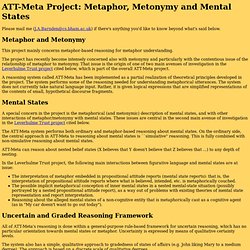
Metaphor and Metonymy This project mainly concerns metaphor-based reasoning for metaphor understanding. The project has recently become intensely concerned also with metonymy and particularly with the contentious issue of the relationship of metaphor to metonymy. METAPHOR-OF-MIND DATABANK: TABLE OF CONTENTS. ATT-Meta Project MENTAL METAPHOR DATABANK. Carnegie Mellon University. Browse the Knowledge Base! Can computers learn to read? We think so. "Read the Web" is a research project that attempts to create a computer system that learns over time to read the web. Carnegie Mellon University. Browse the Knowledge Base!

Can computers learn to read? We think so. "Read the Web" is a research project that attempts to create a computer system that learns over time to read the web. Resources & Data.